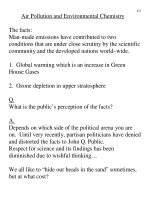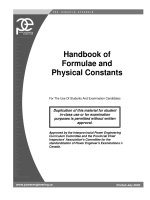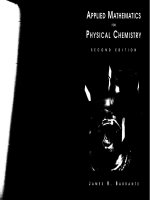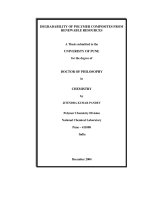Physical Chemistry pdf
Bạn đang xem bản rút gọn của tài liệu. Xem và tải ngay bản đầy đủ của tài liệu tại đây (9.8 MB, 619 trang )
Physical Chemistry
Understanding our Chemical World
Physical Chemistry
Understanding our Chemical World
Paul Monk
Manchester Metropolitan University, UK
Copyright 2004 John Wiley & Sons Ltd, The Atrium, Southern Gate, Chichester,
West Sussex PO19 8SQ, England
Telephone (+44) 1243 779777
Email (for orders and customer service enquiries):
Visit our Home Page on www.wileyeurope.com or www.wiley.com
All Rights Reserved. No part of this publication may be reproduced, stored in a retrieval system or
transmitted in any form or by any means, electronic, mechanical, photocopying, recording, scanning or
otherwise, except under the terms of the Copyright, Designs and Patents Act 1988 or under the terms of
a licence issued by the Copyright Licensing Agency Ltd, 90 Tottenham Court Road, London W1T 4LP,
UK, without the permission in writing of the Publisher. Requests to the Publisher should be addressed
to the Permissions Department, John Wiley & Sons Ltd, The Atrium, Southern Gate, Chichester, West
Sussex PO19 8SQ, England, or emailed to , or faxed to (+44) 1243 770620.
This publication is designed to provide accurate and authoritative information in regard to the subject
matter covered. It is sold on the understanding that the Publisher is not engaged in rendering
professional services. If professional advice or other expert assistance is required, the services of a
competent professional should be sought.
Other Wiley Editorial Offices
John Wiley & Sons Inc., 111 River Street, Hoboken, NJ 07030, USA
Jossey-Bass, 989 Market Street, San Francisco, CA 94103-1741, USA
Wiley-VCH Verlag GmbH, Boschstr. 12, D-69469 We inheim, Germany
John Wiley & Sons Australia Ltd, 33 Park Road, Milton, Queensland 4064, Australia
John Wiley & Sons (Asia) Pte Ltd, 2 Clementi Loop #02-01, Jin Xing Distripark, Singapore 129809
John Wiley & Sons Canada Ltd, 22 Worcester Road, Etobicoke, Ontario, Canada M9W 1L1
Wiley also publishes its books in a variety of electronic formats. Some content that appears
in print may not be available in electronic books.
Library of Congress Cataloging-in-Publication Data
Monk, Paul M. S.
Physical chemistry : understanding our chemical world / Paul Monk.
p. cm.
Includes bibliographical references and index.
ISBN 0-471-49180-2 (acid-free paper) – ISBN 0-471-49181-0 (pbk. :
acid-free paper)
1. Chemistry, Physical and theoretical. I. Title.
QD453.3.M66 2004
541–dc22
2004004224
British Library Cataloguing in Publication Data
A catalogue record for this book is available from the British Library
ISBN 0-471-49180-2 hardback
0-471-49181-0 paperback
Typeset in 10.5/12.5pt Times by Laserwords Private Limited, Chennai, India
Printed and bound in Great Britain by Antony Rowe Ltd, Chippenham, Wiltshire
This book is printed on acid-free paper responsibly manufactured from sustainable forestry
in which at least two trees are planted for each one used for paper production.
Contents
Preface xv
Etymological introduction xix
List of symbols xxiii
Powers of ten: standard prefixes xxviii
1 Introduction to physical chemistry 1
1.1 What is physical chemistry: variables, relationships and laws 1
Why do we warm ourselves by a radiator? 1
Why does water get hot in a kettle? 2
Are these two colours complementary? 2
Does my radio get louder if I vary the volume control? 3
Why does the mercury in a barometer go up when the air pressure
increases? 5
Why does a radiator feel hot to the touch when ‘on’, and cold when ‘off’? 7
1.2 The practice of thermodynamic measurement 9
What is temperature? 9
How long is a piece of string? 14
How fast is ‘greased lightning’? 15
Why is the SI unit of mass the kilogram? 17
Why is ‘the material of action so variable’? 18
1.3 Properties of gases and the gas laws 20
Why do we see eddy patterns above a radiator? 20
Why does a hot-air balloon float? 20
How was the absolute zero of temperature determined? 21
Why pressurize the contents of a g as canister? 23
Why does thunder accompany lightning? 25
How does a bubble-jet printer work? 26
vi CONTENTS
What causes pressure? 30
Why is it unwise to incinerate an empty can of air freshener? 32
1.4 Further thoughts on energy 33
Why is the room warm? 33
What do we mean by ‘room temperature’? 34
Why do we get warmed-through in front of a fire, rather than just our
skins? 35
2 Introducing interactions and bonds 37
2.1 Physical and molecular interactions 37
What is ‘dry ice’? 37
How is ammonia liquefied? 38
Why does steam condense in a cold bathroom? 39
How does a liquid-crystal display work? 40
Why does dew form on a cool morning? 42
How is the three-dimensional structure maintained within the DNA double
helix? 44
How do we make liquid nitrogen? 47
Why is petrol a liquid at room temperature but butane is a gas? 49
2.2 Quantifying the interactions and their influence 50
How does mist form? 50
How do we liquefy petroleum gas? 52
Why is the molar volume of a gas not zero at 0 K? 54
2.3 Creating formal chemical bonds 59
Why is chlorine gas lethal yet sodium chloride is vital for life? 59
Why does a bicycle tyre get hot when inflated? 59
How does a fridge cooler work? 60
Why does steam warm up a cappuccino coffee? 61
Why does land become more fertile after a thunderstorm? 63
Why does a satellite need an inert coating? 64
Why does water have the formula H
2
O? 66
Why is petroleum gel so soft? 67
Why does salt form when sodium and chlorine react? 69
Why heat a neon lamp before it will generate light? 69
Why does lightning conduct through air? 72
Why is argon gas inert? 74
Why is silver iodide yellow? 75
3 Energy and the first law of thermodynamics 77
3.1 Introduction to thermodynamics: internal energy 77
Why does the mouth get cold when eating ice cream? 77
Whyisskinscaldedbysteam? 79
Whydowesweat? 81
Why do we still feel hot while sweating on a humid beach? 83
CONTENTS vii
Why is the water at the top of a waterfall cooler than the water at its base? 85
Why is it such hard work pumping up a bicycle tyre? 86
Why does a sausage become warm when placed in an oven? 87
Why, when letting down a bicycle tyre, is the expelled air so cold? 88
Why does a tyre get hot during inflation? 89
Can a tyre be inflated without a rise in temperature? 89
How fast does the air in an oven warm up? 90
Why does water boil more quickly in a kettle than in a pan on a stove? 91
Why does a match emit heat when lit? 94
Why does it always take 4 min to boil an egg properly? 95
Why does a watched pot always take so long to boil? 98
3.2 Enthalpy 99
How does a whistling kettle work? 99
How much energy do we require during a distillation? 102
Why does the enthalpy of melting ice decrease as the temperature
decreases? 104
Why does water take longer to heat in a pressure cooker than in an open
pan? 106
Why does the temperature change during a reaction? 107
Are diamonds forever? 109
Why do we burn fuel when cold? 111
Why does butane burn with a hotter flame than methane? 114
3.3 Indirect measurement of enthalpy 118
How do we make ‘industrial alcohol’? 118
How does an ‘anti-smoking pipe’ work? 120
Why does dissolving a salt in water liberate heat? 123
Why does our mouth feel cold after eating peppermint? 125
How does a camper’s ‘emergency heat stick’ work? 127
4 Reaction spontaneity and the direction of thermodynamic change 129
4.1 The direction of physicochemical change: entropy 129
Why does the colour spread when placing a drop of dye in a saucer of
clean water? 129
When we spill a bowl of sugar, why do the grains go everywhere and
cause such a mess? 130
Why, when one end of the bath is hot and the other cold, do the
temperatures equalize? 131
Why does a room containing oranges acquire their aroma? 133
Why do damp clothes become dry when hung outside? 134
Why does crystallization of a solute occur? 137
4.2 The temperature dependence of entropy 139
Why do dust particles move more quickly by Brownian motion in warm
water? 139
Why does the jam of a jam tart burn more than does the pastry? 139
viii CONTENTS
4.3 Introducing the Gibbs function 144
Why is burning hydrogen gas in air (to form liquid water) a spontaneous
reaction? 144
How does a reflux condenser work? 144
4.4 The effect of pressure on thermodynamic variables 148
How much energy is needed? 148
Why does a vacuum ‘suck’? 151
Why do we sneeze? 152
How does a laboratory water pump work? 153
4.5 Thermodynamics and the extent of reaction 156
Why is a ‘weak’ acid weak? 156
Why does the pH of the weak acid remain constant? 158
Why does the voltage of a battery decrease to zero? 159
Why does the concentration of product stop changing? 162
Why do chicken eggs have thinner shells in the summer? 165
4.6 The effect of temperature on thermodynamic variables 166
Why does egg white denature when cooked but remain liquid at room
temperature? 166
At what temperature will the egg start to denature? 170
Why does recrystallization work? 171
5 Phase equilibria 177
5.1 Energetic introduction to phase equilibria 177
Why does an ice cube melt in the mouth? 177
Why does water placed in a freezer become ice? 181
Why was Napoleon’s Russian campaign such a disaster? 182
5.2 Pressure and temperature changes with a single-component system:
qualitative discussion 184
How is the ‘Smoke’ in horror films made? 184
How does freeze-drying work? 185
How does a rotary evaporator work? 188
How is coffee decaffeinated? 189
5.3 Quantitative effects of pressure and temperature change for a
single-component system 192
Why is ice so slippery? 192
What is ‘black ice’? 193
Why does deflating the tyres on a car improve its road-holding on ice? 198
Why does a pressure cooker work? 199
5.4 Phase equilibria involving two-component systems: partition 205
Why does a fizzy drink lose its fizz and go flat? 205
How does a separating funnel work? 207
Why is an ice cube only misty at its centre? 208
How does recrystallization work? 209
Why are some eggshells brown and some white? 211
CONTENTS ix
5.5 Phase equilibria and colligative properties 212
Why does a mixed-melting-point determination work? 212
How did the Victorians make ice cream? 216
Why boil vegetables in salted water? 217
Why does the ice on a path melt when sprinkled with salt? 218
5.6 Phase equilibria involving vapour pressure 221
Why does petrol sometimes have a strong smell and sometimes not? 221
How do anaesthetics work? 222
How do carbon monoxide sensors work? 224
Why does green petrol smell different from leaded petrol? 224
Why do some brands of ‘green’ petrol smell different from others? 225
Why does a cup of hot coffee yield more steam than above a cup of
boiling water at the same temperature? 229
How are essential oils for aromatherapy extracted from plants? 229
6 Acids and Bases 233
6.1 Properties of Lowry–Brønsted acids and bases 233
Why does vinegar taste sour? 233
Why is it dangerous to allow water near an electrical appliance, if water is
an insulator? 235
Why is bottled water ‘neutral’? 236
What is ‘acid rain’? 237
Why does cutting an onion make us cry? 239
Why does splashing the hands with sodium hydroxide solution make them
feel ‘soapy’? 239
Why is aqueous ammonia alkaline? 240
Why is there no vinegar in crisps of salt and vinegar flavour? 241
How did soldiers avoid chlorine gas poisoning at the Second Battle of
Ypres? 242
How is sherbet made? 244
Why do steps made of limestone sometimes feel slippery? 244
Why is the acid in a car battery more corrosive than vinegar? 245
Why do equimolar solutions of sulphuric acid and nitric acid have
different pHs? 250
What is the pH of a ‘neutral’ solution? 251
What do we mean when we say blood plasma has a ‘pH of 7.4’? 251
6.2 ‘Strong’ and ‘weak’ acids and bases 253
Why is a nettle sting more painful than a burn from ethanoic acid? 253
Why is ‘carbolic acid’ not in fact an acid? 254
Why does carbonic acid behave as a mono-protic acid? 259
Why is an organic acid such as trichloroethanoic acid so strong? 260
6.3 Titration analyses 261
Why does a dock leaf bring relief after a nettle sting? 261
How do indigestion tablets work? 262
x CONTENTS
6.4 pH buffers 267
Why does the pH of blood not alter after eating pickle? 267
Why are some lakes more acidic than others? 267
How do we make a ‘constant-pH solution’? 270
6.5 Acid–base indicators 273
What is ‘the litmus test’? 273
Why do some hydrangea bushes look red and others blue? 274
Why does phenolphthalein indicator not turn red until pH 8.2? 276
7 Electrochemistry 279
7.1 Introduction to cells: terminology and background 279
Why does putting aluminium foil in the mouth cause pain? 279
Why does an electric cattle prod cause pain? 281
What is the simplest way to clean a tarnished silver spoon? 282
How does ‘electrolysis’ stop hair growth? 283
Why power a car with a heavy-duty battery yet use a small battery in a
watch? 283
How is coloured (‘anodized’) aluminium produced? 285
How do we prevent the corrosion of an oil rig? 286
What is a battery? 288
Why do hydrogen fuel cells sometimes ‘dry up’? 289
Why bother to draw cells? 291
Why do digital watches lose time in the winter? 293
Why is a battery’s potential not constant? 294
What is a ‘standard cell’? 295
Why aren’t electrodes made from wood? 300
Why is electricity more dangerous in wet weather? 302
7.2 Introducing half-cells and electrode potentials 303
Why are the voltages of watch and car batteries different? 303
How do ‘electrochromic’ car mirrors work? 305
Why does a potential form at an electrode? 306
7.3 Activity 308
Why does the smell of brandy decrease after dissolving table salt in it? 308
Why does the smell of gravy become less intense after adding salt to it? 308
Why add alcohol to eau de Cologne? 309
Why does the cell emf alter after adding LiCl? 312
Why does adding NaCl to a cell alter the emf, but adding tonic water
doesn’t? 314
Why does MgCl
2
cause a greater decrease in perceived concentration than
KCl? 315
Why is calcium better than table salt at stopping soap lathering? 316
Why does the solubility of AgCl change after adding MgSO
4
? 318
7.4 Half-cells and the Nernst equation 321
Why does sodium react with water yet copper doesn’t? 321
CONTENTS xi
Why does a torch battery eventually ‘go flat’? 325
Why does E
AgCl,Ag
change after immersing an SSCE in a solution of salt? 326
Why ‘earth’ a plug? 328
7.5 Concentration cells 333
Why does steel rust fast while iron is more passive? 333
How do pH electrodes work? 336
7.6 Transport phenomena 339
How do nerve cells work? 339
What is a ‘salt bridge’? 342
7.7 Batteries 343
How does an electric eel produce a current? 343
What is the earliest known battery? 345
8 Chemical kinetics 349
8.1 Kinetic definitions 349
Why does a ‘strong’ bleach clean faster than a weaker one does? 349
Why does the bleaching reaction eventually stop? 351
Why does bleach work faster on some greases than on others? 354
Why do copper ions amminate so slowly? 356
How fast is the reaction that depletes the ozone layer? 358
Why is it more difficult to breathe when up a mountain than at ground
level? 359
8.2 Qualitative discussion of concentration changes 361
Why does a full tank of petrol allow a car to travel over a constant
distance? 361
Why do we add a drop of bromine water to a solution of an alkene? 362
When magnesium dissolves in aqueous acid, why does the amount of
fizzing decrease with time? 364
8.3 Quantitative concentration changes: integrated rate equations 368
Why do some photographs develop so slowly? 368
Why do we often refer to a ‘half-life’ when speaking about radioactivity? 378
How was the Turin Shroud ‘carbon dated’? 382
How old is
¨
Otzi the iceman? 385
Why does the metabolism of a hormone not cause a large chemical change
in the body? 387
Why do we not see radicals forming in the skin while sunbathing? 388
8.4 Kinetic treatment of complicated reactions 393
Why is arsenic poisonous? 393
Why is the extent of Walden inversion smaller when a secondary alkyl
halide reacts than with a primary halide? 394
Why does ‘standing’ a bottle of wine cause it to smell and taste better? 397
Why fit a catalytic converter to a car exhaust? 399
Why do some people not burn when sunbathing? 400
How do Reactolite
sunglasses work? 403
xii CONTENTS
8.5 Thermodynamic considerations: activation energy, absolute reaction rates
and catalysis 408
Why prepare a cup of tea with boiling water? 408
Why store food in a fridge? 408
Why do the chemical reactions involved in cooking require heating? 409
Why does a reaction speed up at higher temperature? 411
Why does the body become hotter when ill, and get ‘a temperature’ ? 415
Why are the rates of some reactions insensitive to temperature? 416
What are catalytic converters? 420
9 Physical chemistry involving light: spectroscopy and
photochemistry 423
9.1 Introduction to photochemistry 423
Why is ink coloured? 423
Why do neon streetlights glow? 424
Why do we get hot when lying in the sun? 425
Why is red wine so red? 426
Why are some paints red, some blue and others black? 427
Why can’t we see infrared light with our eyes? 429
How does a dimmer switch work? 433
Why does UV-b cause sunburn yet UV-a does not? 434
How does a suntan protect against sunlight? 436
How does sun cream block sunlight? 439
Why does tea have a darker colour if brewed for longer? 442
Why does a glass of apple juice appear darker when viewed against a
white card? 442
Why are some paints darker than others? 444
What is ink? 445
9.2 Photon absorptions and the effect of wavelength 446
Why do radical reactions usually require UV light? 446
Why does photolysis require a powerful lamp? 452
Why are spectroscopic bands not sharp? 453
Why does hydrogen look pink in a glow discharge? 455
Why do surfaces exposed to the sun get so dusty? 457
Why is microwave radiation invisible to the eye? 458
9.3 Photochemical and spectroscopic selection rules 459
Why is the permanganate ion so intensely coloured? 459
Why is chlorophyll green? 461
Why does adding salt remove a blood stain? 462
What is gold-free gold paint made of? 462
What causes the blue colour of sapphire? 463
Why do we get hot while lying in the sun? 464
What is an infrared spectrum? 467
Why does food get hot in a microwave oven? 469
Are mobile phones a risk to health? 471
CONTENTS xiii
9.4 Photophysics: emission and loss processes 472
How are X-rays made? 472
Why does metal glow when hot? 473
How does a light bulb work? 474
Why is a quartz–halogen bulb so bright? 474
What is ‘limelight’? 476
Why do TV screens emit light? 476
Why do some rotting fish glow in the dark? 478
How do ‘see in the dark’ watch hands work? 479
How do neon lights work? 480
How does a sodium lamp work? 481
How do ‘fluorescent strip lights’ work? 482
9.5 Other optical effects 483
Why is the mediterranean sea blue? 483
Do old-master paintings have a ‘fingerprint’? 485
10 Adsorption and surfaces, colloids and micelles 487
10.1 Adsorption and definitions 487
Why is steam formed when ironing a line-dried shirt? 487
Why does the intensity of a curry stain vary so much? 489
Why is it difficult to remove a curry stain? 492
Why is iron the catalyst in the Haber process? 494
Why is it easier to remove a layer of curry sauce than to remove a curry
stain? 496
How does water condense onto glass? 497
How does bleach remove a dye stain? 498
How much beetroot juice does the stain on the plate contain? 499
Why do we see a ‘cloud’ of steam when ironing a s hirt? 503
10.2 Colloids and interfacial science 504
Why is milk cloudy? 504
What is an ‘aerosol’ spray? 505
What is ‘emulsion paint’? 506
Why does oil not mix with water? 508
10.3 Colloid stability 509
How are cream and butter made? 509
How is chicken soup ‘clarified’ by adding eggshells? 510
How is ‘clarified butter’ made? 510
Why does hand cream lose its milky appearance during hand rubbing? 511
Why does orange juice cause milk to curdle? 512
How are colloidal particles removed from waste water? 513
10.4 Association colloids: micelles 514
Why does soapy water sometimes look milky? 514
What is soap? 517
Why do soaps dissolve grease? 518
xiv CONTENTS
Why is old washing-up water oily when cold but not when hot? 519
Why does soap generate bubbles? 521
Why does detergent form bubbles? 522
Answers to SAQs 525
Bibliography 533
Index 565
Preface
This book
Some people make physical chemistry sound more confusing than it really is. One of
their best tricks is to define it inaccurately, saying it is ‘the physics of chemicals’. This
definition is sometimes quite good, since it suggests we look at a chemical system and
ascertain how it follows the laws of nature. This is true, but it suggests that chemistry
is merely a sub-branch of physics; and the notoriously mathematical nature of physics
impels us to avoid this otherwise useful way of looking at physical chemistry.
An alternative and more user-friendly definition tells us that physical chemistry
supplies ‘the laws of chemistry’, and is an addition to the making of chemicals. This
is a superior lens through which to view our topic because we avoid the bitter aftertaste
of pure physics, and start to look more closely at physical chemistry as an applied
science: we do not look at the topic merely for the sake of looking, but because
there are real-life situations requiring a scientific explanation. Nevertheless, most
practitioners adopting this approach are still overly mathematical in their treatments,
and can make it sound as though the science is fascinating in its own right, but will
sometimes condescend to suggest an application of the theory they so clearly relish.
But the definition we will employ here is altogether simpler,
Now published as Rev-
elations of Divine Love,
by Mother Julian of
Norwich.
and also broader: we merely ask ‘why does it happen?’ as we
focus on the behaviour of each chemical system. Every example
we encounter in our everyday walk can be whittled down into
small segments of thought, each so simple that a small child can
understand. As a famous mystic of the 14th century once said, ‘I
saw a small hazelnut and I marvelled that everything that exists could be contained
within it’. And in a sense she was right: a hazelnut looks brown because of the way
light interacts with its outer shell – the topic of spectroscopy (Chapter 9); the hazelnut
is hard and solid – the topic of bonding theory (Chapter 2) and phase equilibria
(Chapter 5); and the nut is good to eat – we say it is readily metabolized, so we think
xvi PREFACE
of kinetics (Chapter 8); and the energetics of chemical reactions (Chapters 2–4). The
sensations of taste and sight are ultimately detected within the brain as electrical
impulses, which we explain from within the rapidly growing field of electrochemistry
(Chapter 7). Even the way a nut sticks to our teeth is readily explained by adsorption
science (Chapter 10). Truly, the whole of physical chemistry can be encompassed
within a few everyday examples.
So the approach taken here is the opposite to that in most other books of physical
chemistry: each small section starts with an example from everyday life, i.e. both the
world around us and also those elementary observations that a chemist can be certain
to have pondered upon while attending a laboratory class. We then work backwards
from the experiences of our hands and eyes toward the cause of why our world is
the way it is.
Nevertheless, we need to be aware that physical chemistry is not a closed book in
the same way of perhaps classical Latin or Greek. Physical chemistry is a growing
discipline, and new experimental techniques and ideas are continually improving the
data and theories with which our understanding must ultimately derive.
Inevitably, some of the explanations here have been over-simplified because phys-
ical chemistry is growing at an alarming rate, and additional sophistications in theory
and experiment have yet to be devised. But a more profound reason for caution is
in ourselves: it is all too easy, as scientists, to say ‘Now I understand!’ when in fact
we mean that all the facts before us can be answered by the theory. Nevertheless, if
the facts were to alter slightly – perhaps we look at another kind of nut – the theory,
as far as we presently understand it, would need to change ever so slightly. Our
understanding can never be complete.
So, we need a word about humility. It is said, probably too often, that science is
not an emotional discipline, nor is there a place for any kind of reflection on the
human side of its application. This view is deeply mistaken, because scientists limit
themselves if they blind themselves to any contradictory evidence when sure they
are right. The laws of physical chemistry can only grow when we have the humility
to acknowledge how incomplete is our knowledge, and that our explanation might
need to change. For this reason, a simple argument is not necessary the right one; but
neither is a complicated one. The examples in this book were chosen to show how
the world around us manifests Physical Chemistry. The explanation of a seemingly
simple observation may be fiendishly complicated, but it may be beautifully simple. It
must be admitted that the chemical examples are occasionally artificial. The concept
of activity, for example, is widely misunderstood, probably because it presupposes
knowledge from so many overlapping branches of physical chemistry. The examples
chosen to explain it may be quite absurd to many experienced teachers, but, as
an aid to simplification, they can be made to work. Occasionally the science has
been simplified to the point where some experienced teachers will maintain that it is
technically wrong. But we must start from the beginning if we are to be wise, and
only then can we progress via the middle and physical chemistry is still a rapidly
growing subject, so we don’t yet know where it will end.
While this book could be read as an almanac of explanations, it provides students
in further and higher education with a unified approach to physical chemistry. As a
PREFACE xvii
teacher of physical chemistry, I have found the approaches and examples here to be
effective with students of HND and the early years of BSc and MChem courses. It has
been written for students having the basic chemical and mathematical skills generally
expected of university entrants, such as rearrangement of elementary algebra and a
little calculus. It will augment the skills of other, more advanced, students.
To reiterate, this book supplies no more than an introduction to physical chemistry,
and is not an attempt to cover the whole topic. Those students who have learned
some physical chemistry are invited to expand their vision by reading more special-
ized works. The inconsistencies and simplifications wrought by lack of space and
style in this text will be readily overcome by copious background reading. A com-
prehensive bibliography is therefore included at the end of the book. Copies of the
figures and bibliography, as well as live links can be found on the book’s website at
/>Acknowledgements
One of the more pleasing aspects of writing a text such as this is the opportunity to
thank so many people for their help. It is a genuine pleasure to thank Professor S
´
eamus
Higson of Cranfield University, Dr Roger Mortimer of Loughborough University,
and Dr Michele Edge, Dr David Johnson, Dr Chris Rego and Dr Brian Wardle from
my own department, each of whom read all or part of the manuscript, and whose
comments have been so helpful.
A particular ‘thank you’ to Mrs Eleanor Riches, formerly a high-school teacher,
who read the entire manuscript and made many perceptive and helpful comments.
I would like to thank the many students from my department who not only saw
much of this material, originally in the form of handouts, but whose comments helped
shape the material into its present form.
Please allow me to thank Michael Kaufman of The Campaign for a Hydrogen Econ-
omy (formerly the Hydrogen Association of UK and Ireland ) for helpful discussions
to clarify the arguments in Chapter 7, and the Tin Research Council for their help in
constructing some of the arguments early in Chapter 5.
Concerning permission to reproduce figures, I am indebted to The Royal Society of
Chemistry for Figures 1.8 and 8.26, the Open University Press for Figure 7.10, Else-
vier Science for Figures 4.7 and 10.3, and John Wiley & Sons for Figures 7.19, 10.11
and 10.14. Professor Robin Clarke
FRS of University College London has graciously
allowed the reproduction of Figure 9.28.
Finally, please allow me to thank Dr Andy Slade, Commissioning Editor of Wiley,
and the copy and production editors Rachael Ballard and Robert Hambrook. A special
thank you, too, to Pete Lewis.
Paul Monk
Department of Chemistry & Materials
Manchester Metropolitan University
Manchester
Etymological
introduction
The hero in The Name of the Rose is a medieval English monk. He acts as sleuth,
‘‘Etymology’’ means
the derivation of a
word’s meaning.
and is heard to note at one point in the story how, ‘The study of words is the
whole of knowledge’. While we might wish he had gone a little
further to mention chemicals, we would have to agree that many
of our technical words can be traced back to Latin or Greek roots.
The remainder of them originate from the principal scientists who
pioneered a particular field of study, known as etymology.
Etymology is our name for the science of words, and describes the sometimes-
tortuous route by which we inherit them from our ancestors. In fact, most words
change and shift their meaning with the years. A classic example describes how King
George III, when first he saw the rebuilt St Paul’s Cathedral in London, described it
as ‘amusing, artificial and awful’, by which he meant, respectively, it ‘pleased him’,
was ‘an artifice’ (i.e. grand) and was ‘awesome’ (i.e. breathtaking).
Any reader will soon discover the way this text has an unusual etymological empha-
sis: the etymologies are included in the belief that taking a word apart actually helps us
to understand it and related concepts. For example, as soon as we know the Greek for
‘green’ is chloros, we understand better the meanings of the proper nouns chlorophyll
and chlorine, both of which are green. Incidentally, phyll comes from the Greek for
‘leaf’, and ine indicates a substance.
Again, the etymology of the word oxygen incorporates much historical informa-
tion: oxys is the Greek for ‘sharp’, in the sense of an extreme sensory experience,
such as the taste of acidic vinegar, and the ending gen comes from gignesthaw (pro-
nounced ‘gin-es-thaw’), meaning ‘to be produced’. The classical roots of ‘oxygen’
reveal how the French scientists who first made the gas thought they had isolated the
distinguishing chemical component of acids.
The following tables are meant to indicate the power of this approach. There are
several dozen further examples in the text. The bibliography on p. 533 will enable
the interested reader to find more examples.
Words derived from a scientist’s name
Scientist Field of study Present meaning(s) Derived words
a
Amp
`
ere, Andr
´
e current, electricity current amp (unit of current); amperometry;
amperometric; voltammetry
Coulomb, Charles charge, electricity charge passed coulomb (unit of charge); coulombic
Faraday, Michael capacitance, electrochemistry electricity faraday (molar electronic charge); faradaic;
farad (unit of capacitance)
Voltaire, Allesandro electricity, potential potential volt (unit of potential); voltaic; voltammetry
a
Note that derived words do not start with a capital letter.
Words and roots from Latin
Word or root Original Latin meaning Modern meaning Modern examples Scientific examples
Centi(n)s hundred times hundred century, cent (= $/100) centi (symbol c) = factor of 10
2
Decie(n)s ten times ten decimate (i.e. to kill 1
in 10)
deci (symbol d) factor of 10
decimal decimetre (= metre ÷ 10)
Giga(n)s giant very large gigantic giga (symbol G) = factor of 10
9
Milli thousand, thousands thousand, thousandth millipede, millennium milli (symbol m) = factor of 10
−3
Stratum bed, couch, coverlet something beneath stratify (many layered) strata of rock (in geology)
substrate (chemistry and physics)
Sub under, beneath,
directly under
below, less than subterfuge, subterranean
sub-standard, subset
substrate (i.e. underlying strata)
subscript (in typesetting)
Super above, on, over, on
top of
above, bigger than superstar, superlative superscript (in typesetting)
Words and roots from Greek
Word or root Original Greek meaning Modern meaning Modern examples Scientific examples
Anode (ανoδoς ) ascent positive electrode anode anode, anodic, anodize
Baro (βαρoς ) weigh down, heaviness to do with atmosphere barometer, barometric barometer, isobar, bar (unit of pressure)
Cathode (καθoδoς ) descent negative electrode cathode cathode, cathodic, cathodize
Cyclo (κυκλoς) circle, circular cycle, circle bicycle, cylinder, cyclone cyclotron, cyclization
Di (δις ) two, twice to do with two dihedral to do with two (coordination chemistry)
dilemma (two options) dimer, di-stereoisomer (i.e. one of two images)
Iso (ισ o) level, equality same Isomer e.g. isobutane, isomer
Kilo (κιλoς) lots of, many factor of a thousand Kilometre kilo (symbol k) = factor of 10
3
Mega (µεγ α-) great, large very large megabyte mega (symbol M) = factor of 10
6
Mesos (µεσ oς) middle, mid mid, intermediate mezzanine (mid floor) mesophase (i.e. phase between two extremes)
Meta (µετ α-) afterwards after, beyond metaphor (i.e. beyond the real
meaning)
position beyond ortho on a ring
metathesis (i.e. product of mixing)
Meter (µετρητ ης) meter a meter, to meter gas meter, metrical barometer (i.e. measures pressure)
Micro (µιχρoς) small tiny, small microscope, micrometer micro (symbolµ) = factor of 10
−6
Mono (µoνoς) one one, alone monorail, monologue
monotonous (i.e. on one note)
monomer, e.g. mono-substituted
Ortho (oρθoς ) straight straight, right orthodox (i.e. to the standard)
othopædic (straightening bones)
adjacent position on a ring
Para (παρα-) near, beyond, contrary opposite paranormal (beyond normal)
paradox (contrary to standard)
position opposite the primary carbon
Tetra (τετταρεoς) four, four times to do with four tetrahedron to do with four (in coodination chemistry)
Thermo (θ ερµo) energy, temperature Heat thermos, thermometer thermos, thermometer
List of Symbols
Symbols for variables
a Activity
a van der Waals constant
A optical absorbance
A Area
b van der Waals constant
B
virial coefficient
c concentration
c the intercept on the y-axis of a graph
c constant of proportionality
C virial coefficient
C heat capacity
C
p
heat capacity determined at constant
pressure
C
V
heat capacity determined at constant
volume
E energy
E potential
E
a
activation energy
E
(ea)
electron affinity
E
j
junction potential
E
(load)
potential of a battery or cell when
passing a current
emf potential of a cell, determined at zero
current
E
O,R
electrode potential for the couple
O + ne
−
= R
E
O
O,R
standard electrode potential for the
couple O + ne
−
= R
E
(LHS)
electrode potential of the negative
electrode in a cell
E
(RHS)
electrode potential of the positive
electrode in a cell
f fugacity
f frequency
F force
G Gibbs function
G change in Gibbs function
G
O
standard Gibbs function
G
‡
Gibbs function of activation
h height
H enthalpy
H change in enthalpy
H
(ads)
enthalpy of adsorption
H
O
standard enthalpy
H
BE
bond enthalpy
H
c
enthalpy of combustion
H
f
enthalpy of formation
H
‡
enthalpy of activation
I electrical current
I intensity of light following absorption
xxiv LIST OF SYMBOLS
I
o
intensity of incident light beam
I ionic strength
I ionization energy
J rotational quantum number; rotational
quantum number of an excited
state
J
rotational quantum number of ground
state
k force constant of a bond
k proportionality constant
k rate constant
k
pseudo rate constant
k
n
rate constant of an nth-order reaction
k
−n
rate constant for the back reaction of
an nth-order reaction
k
(n)
rate constant of the nth process in a
multi-step reaction
k
a
rate constant of adsorption
k
d
rate constant of desorption
k
H
Henry’s law constant
K equilibrium constant
K correction constant of an ion-selective
electrode
K
a
acidity constant (‘acid dissociation’
constant)
K
a(n)
acidity constant for the nth
dissociation reaction
K
b
basicity constant
K
c
equilibrium constant formulated in
terms of concentration
K
p
equilibrium constant formulated in
terms of pressure
K
s
equilibrium constant of solubility
(sometimes called ‘solubility
product’ or ‘solubility constant’)
K
w
autoprotolysis constant of water
K
‡
equilibrium constant of forming a
transition state ‘complex’
l length
m gradient of a graph
m mass
M relative molar mass
n number of moles
n number of electrons in a redox
reaction
n
m
amount of material in an adsorbed
monolayer
N number
p pressure
p
(i)
partial pressure of component i
p
O
(i)
vapour pressure of pure i
p
O
standard pressure of 10
5
Pa
q heat energy
Q charge
Q reaction quotient
r separation between ions
r radius of a circle or sphere
r bond length
r
bond length in an optically excited
species
r
o
equilibrium bond length
R electrical resistance
s solubility
s stoichiometric ratio
S entropy
S change in entropy
S
O
standard entropy
S
‡
entropy of activation
t time
t
1
2
half life
T temperature
T optical transmittance
T
o
optical transmittance without a sample
T
K
Krafft temperature
U internal energy
U change in internal energy, e.g. during
reaction
v quantum-number of vibration
v
quantum-number of vibration in an
excited-state species









